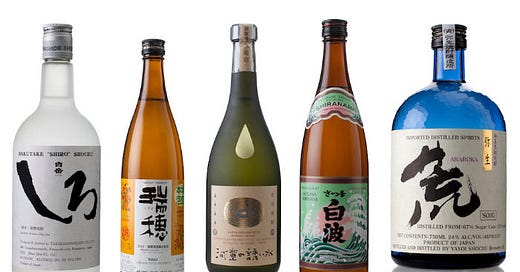Dear Drink To That reader,
Your industry report this week is about looking into the fascinating world of Japanese shochu.
As a sake educator and Japanese drinks guy, I’ve got a particular sense of pride and excitement to be sharing these trends and insights with you.
An increase in Western education
For years, Japanese whisky has arguably been the most prominent spirit associated with the Land of The Rising Sun in the Western consumer’s mind. This is slowly changing for the better with an increase in shochu educators and programmes focused on championing Japan’s indigenous spirit.
For example, there has been a recent push to promote premium honkaku (single-distilled) shochu in the UK through the likes of the Japanese Sake and Shochu Makers Association and UK Bartender’s Guild through tastings in London. Japanese drinks consultant Sam Boulton has also been championing the spirit through his Kokushu brand and informative book The Art of Mixing Koji Cocktails.
The UK certainly has its share of talented shochu bartenders. Edinburgh-based Fabio Di Silvestro won the 2025 Great Honkaku & Awamori Contest that the UK Bartenders’ Guild organised. His entry Yabukita Snap was a nod to Japan’s famous Bamboo cocktail.
He told Bar Magazine “I wanted to celebrate the complexity and richness of shochu, a spirit that combines elements of both whisky and sake, and pair it with the beautiful flavours of Yabukita tea from Kyushu island.”
In Europe, Shochu Do led by a trio of drink educators and ambassadors is introducing shochu to Spain and beyond. Co-founder Elvira Aldaz told me “In Spain, we are at the first steps of this education process. Sake, never mind shochu, is still an unknown beverage for most of the customers, even sommeliers. Bartenders still tend to confuse sake and shochu, and that’s if they have heard of them!
But Japanese cuisine is huge here, with a lot of new high-end Japanese restaurants opening every day and being a success. So, a lot of people love Japanese food and it’s only a matter of time before they want to learn more about the drinks. Also, the number of Spanish tourists travelling to Japan is growing year on year and that’s important for increasing awareness about Japanese drinks generally. Many people who’ve had an amazing time in Japan come back and talk to their friends about sake and shochu.
At this early stage, we’re raising awareness of Japanese drinks through shochu masterclasses and writing about it for different media outlets and are excited about what the future holds.”
In Japan and the US, shochu stalwart Christopher Pellegrini is consistently banging the drum with his consultancy background, tasting classes and more.
Shochu highballs offer the best accessibility
Cocktails remain the simplest way for bartenders to introduce shochu to new audiences and they appeal because of earthy and umami-driven notes. A favoured recipe among bartenders is the shochu highball because of its refreshing quality and simplicity.
Several industry folks recently spoke to Forbes about their preference for shochu highballs. Jopus Grevenlink, the Senior Beverage Manager at Jose Andres Group in New York said “As a spirit category, shochu offers so much depth and complexity, largely due to the many bases that shochu can be produced from. There are fruity and tropical expressions of shochu, such as the Colourful, which is made from sweet potatoes.
There is even shochu made from brown sugar, nuts, rice and many other bases that all offer wildly different and subtle notes when combined with club soda to form a highball.”
Mamoru Tashiro, bartender at Hakubai within the Prince Kitano New York hotel said “I always find myself making a sweet potato shochu highball when guests ask for my bartender’s choice, or when I’m in the mood for something and can’t quite put my finger on what it is exactly. My parents drank sweet potato shochu around me growing up. Unlike rice or barley shochu (which have strong aromas), sweet potato shochu is not as fragrant. Drinking it makes me nostalgic and reminds me of my parents & my childhood in Japan.”
Top performing shochu brands in the West
Iichiko: This brand is arguably the most well-known craft shochu in the Western market. It’s a barley-based spirit with attractive packaging and broad flavours that suit casual dining.
Kuro Kirishima: Popular across Japan and beyond, this sweet potato shochu is a mainstay on restaurant and bar menus. It has a rich, earthy flavour that appeals to whisky drinkers.
Satsuma Shiranami: Another sweet potato shochu, this brand honours traditional production methods.
As always, let me know what you think of these trends by getting in touch via infodrinktothat@gmail.com
Cheers to you,
Jamie




